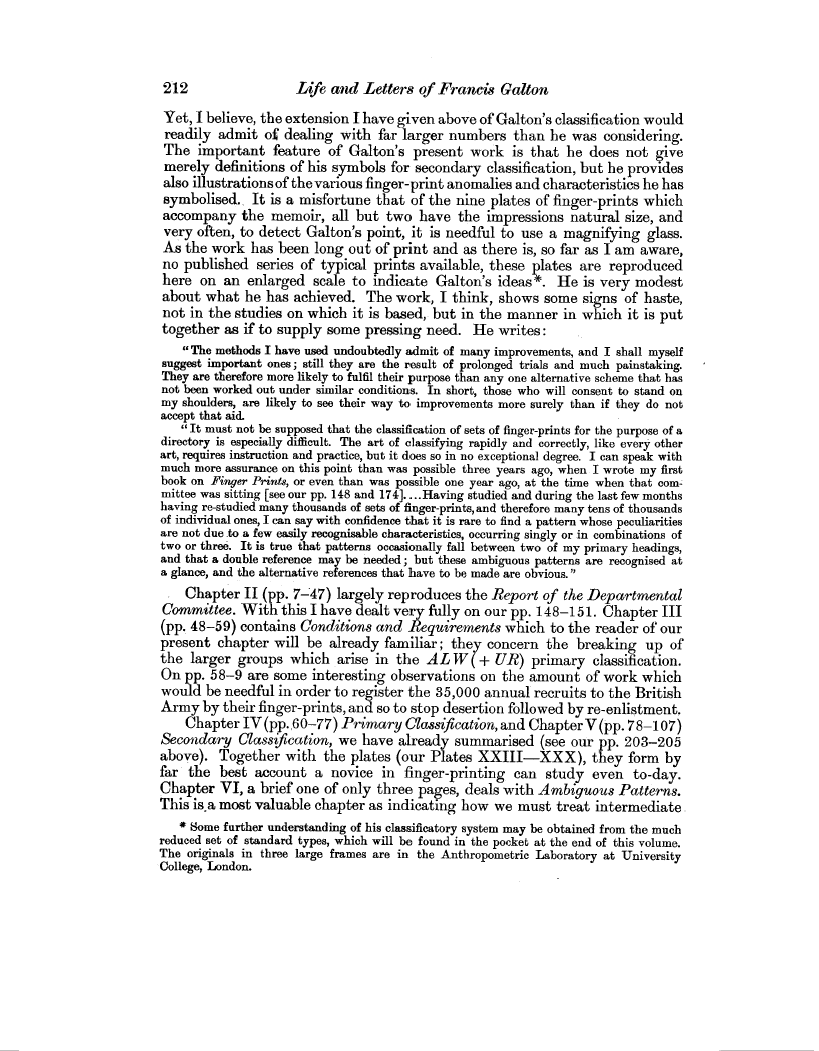| ||||||

OCR Rendition - approximate
212 Life and Letters of Francis Calton Yet, I believe, the extension I have given above of Galton's classification would readily admit off dealing with far larger numbers than he was considering. The important feature of Galton's present work is that he does not give merely definitions of his symbols for secondary classification, but he provides also illustrations of the various finger-print anomalies and characteristics he has symbolised._ It is a misfortune that of the nine plates of finger-prints which accompany the memoir, all but two have the impressions natural size, and very often, to detect Galton's point, it is needful to use a magnifying glass. As the work has been long out of print and as there is, so far as I am aware, no published series of typical prints available, these plates are reproduced here on an enlarged scale to indicate Galton's ideas*. He is very modest about what he has achieved. The work, I think, shows some signs of haste, not in the studies on which it is based, but in the manner in which it is put together as if to supply some pressing need. He writes "The methods I have used undoubtedly admit of many improvements, and I shall myself suggest important ones; still they are the result of prolonged trials and much painstaking. They are therefore more likely to fulfil their purpose than any one alternative scheme that has not been worked out under similar conditions. In short, those who will consent to stand on my shoulders, are likely to see their way to improvements more surely than if they do not accept that aid. "It must not be supposed that the classification of sets of finger-prints for the purpose of a directory is especially difficult. The art of classifying rapidly and correctly, like every other art, requires instruction and practice, but it does so in no exceptional degree. I can speak with much more assurance on this point than was possible three years ago, when I wrote my first book on Finger Prints, or even than was possible one year ago, at the time when that committee was sitting [see our pp. 148 and 174]....Having studied and during the last few months having re-studied many thousands of sets of finger-prints, and therefore many tens of thousands of individual ones, I can say with confidence that it is rare to find a pattern whose peculiarities are not due .to a few easily recognisable characteristics, occurring singly or in combinations of two or three. It is true that patterns occasionally fall between two of my primary headings, and that a double reference may be needed ; but these ambiguous patterns are recognised at a glance, and the alternative references that have to be made are obvious. " . Chapter II (pp. 7-47) largely reproduces the Report of the Departmental
* Some further understanding of his classificatory system may be obtained from the much reduced set of standard types, which will be found in the pocket at the end of this volume. The originals in three large frames are in the Anthropometric Laboratory at University College, London.
|